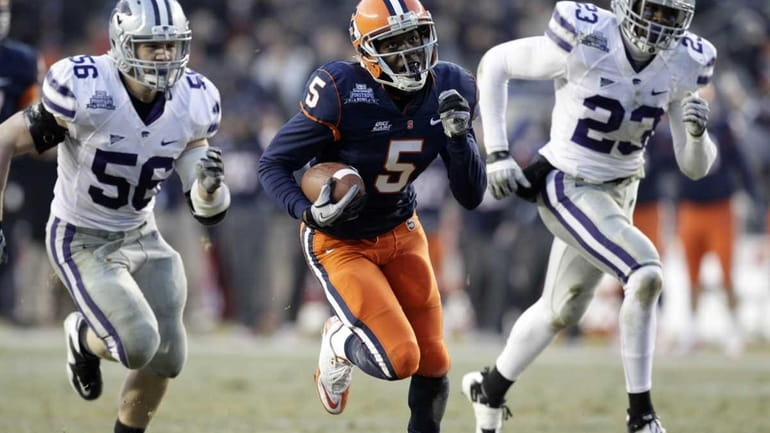Big East's football future looks OK

After catching a 36-yard pass, Syracuse wide receiver Marcus Sales runs toward the end zone for a second-quarter touchdown while pursued by Kansas State linebacker Alex Hrebec and cornerback Emmanuel Lamur during the Pinstripe Bowl at Yankee Stadium, Thursday. (Dec. 30, 2010) Credit: AP
The dominos are set to fall again in college athletics on the heels of Texas A&M's recent announcement it plans to leave the Big 12 Conference. A year ago, the prospect of more upheaval would have sparked fears about the Big East's future as one of six BCS conferences, but the league added TCU's powerful football program for 2012 and the anticipation of a major TV deal next fall has restored sound footing.
"As we approach our upcoming television negotiations starting in September of 2012, there's no question we're extremely well-positioned," Big East commissioner John Marinatto told Newsday. "This next round of negotiations will propel us to a place where we'll be achieving equity with the other major conferences in terms of revenue and exposure."
The Big East has a football contract with ESPN through the 2013 regular season and has basketball contracts with CBS and ESPN through the 2012-13 season, but everything will be on the table next fall. The Big East could renegotiate with its current partners right now, but if the league wants to explore the market with all networks or even form its own network, it must go through the exclusive negotiating window with ESPN and CBS that opens next fall.
Marinatto chose to wait for the exclusive negotiating period to allow the market to set itself, and because it's also possible the Big East could add to its football schools by then. Outlining his pitch to the networks, Marinatto noted that seven league members are located in the top 14 media markets and 12 [including non-football schools] in the top 35 markets. The Big East has more television households than any conference in the country, and the addition of the Dallas-Fort Worth market expands its coverage from 25 percent of the country to 30 percent.
Of course, Marinatto faces a unique set of problems holding his league together. TCU gives it nine BCS-level football schools, but it also expands the basketball wing to an unwieldy 19 teams. That eventually could force a football-basketball split, but West Virginia athletic director Oliver Luck believes the odd configuration can work.
"As I sit in on our meetings between the football and basketball ADs, I don't feel a split," Luck said. "I'm from the football side and realize how important football is in the grand scheme, but ... the basketball success has really given all of us a sense we've got a great asset. If we can move our football up a little bit, we're going to be in a great position moving forward.
"I hope I'm not whistling past the graveyard, but I sincerely believe the addition of TCU will make us a better conference. We're certainly more stable than the Big 12 and maybe even the ACC with all the scandals they've had to endure. The Big East is in a pretty good position, which most folks didn't give them credit for just six months ago."
The SEC, Big Ten and Pac-12 are secure, but some believe the Big East is in a survival fight as a BCS conference with the Big 12 and ACC. Marinatto recently reached out to Big 12 commissioner Dan Beebe and ACC commissioner John Swofford to explore ways to work together.
"My goal was to see if there's anything we can do together to help each other, not to hurt each other," Marinatto said. "It could be how we collaborate to create a television network or an interleague schedule."
Ultimately, the Big East needs three more major football schools to meet the 12-team requirement for a conference championship game, so, expansion is in its future. "We'll continue to study it," Marinatto said, "and if we can find a match that brings us value and makes sense, we'll move forward."
